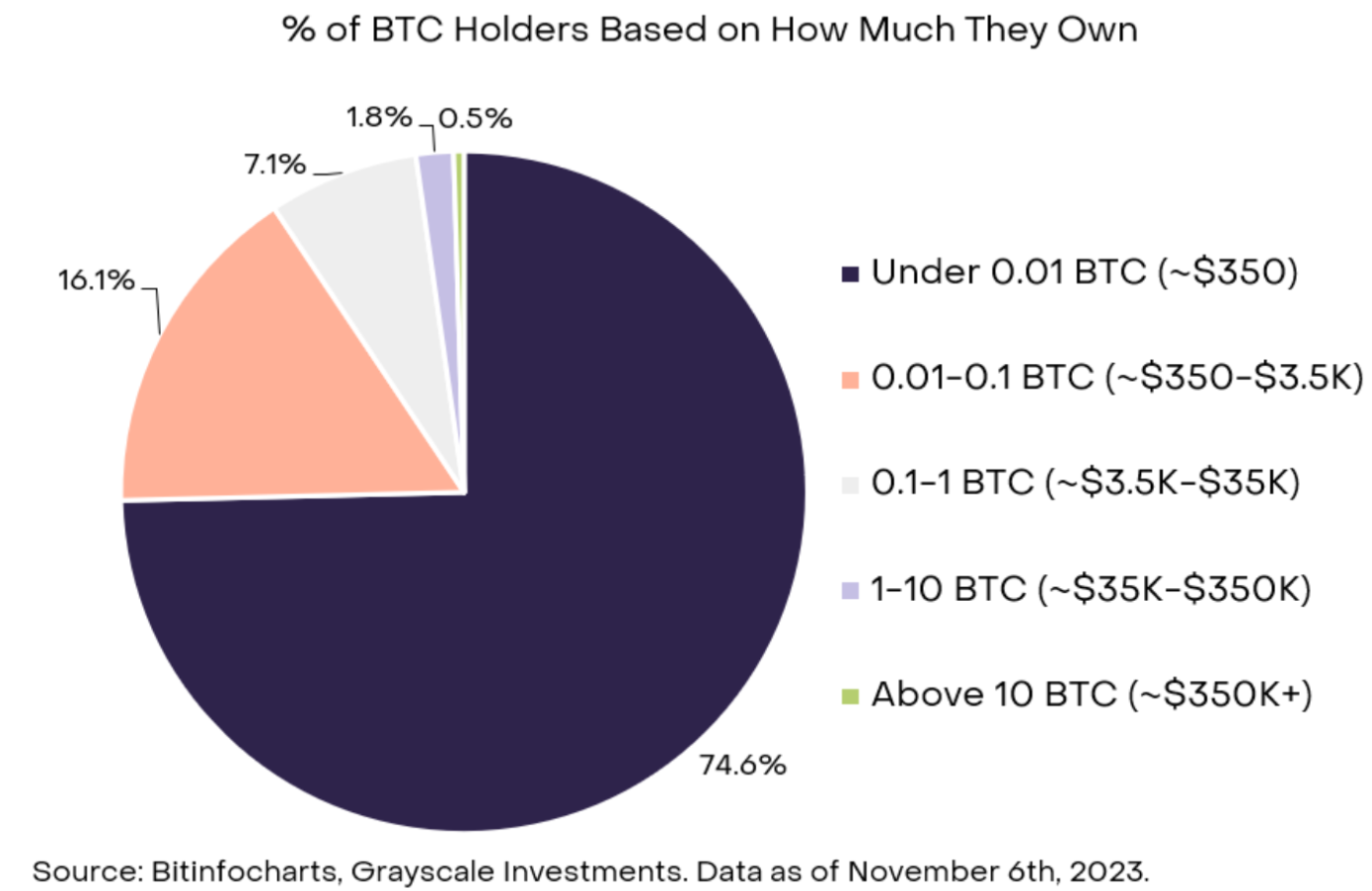| COINOTAG recommends • Exchange signup |
| 💹 Trade with pro tools |
| Fast execution, robust charts, clean risk controls. |
| 👉 Open account → |
| COINOTAG recommends • Exchange signup |
| 🚀 Smooth orders, clear control |
| Advanced order types and market depth in one view. |
| 👉 Create account → |
| COINOTAG recommends • Exchange signup |
| 📈 Clarity in volatile markets |
| Plan entries & exits, manage positions with discipline. |
| 👉 Sign up → |
| COINOTAG recommends • Exchange signup |
| ⚡ Speed, depth, reliability |
| Execute confidently when timing matters. |
| 👉 Open account → |
| COINOTAG recommends • Exchange signup |
| 🧭 A focused workflow for traders |
| Alerts, watchlists, and a repeatable process. |
| 👉 Get started → |
| COINOTAG recommends • Exchange signup |
| ✅ Data‑driven decisions |
| Focus on process—not noise. |
| 👉 Sign up → |
- Bitcoin’s ownership is more distributed than commonly perceived, with a variety of holders globally.
- Approximately 74% of Bitcoin owners hold less than 0.01 BTC, demonstrating a decentralized ownership structure.
- “Sticky supply” from specific groups could amplify the impact of upcoming events like the 2024 Bitcoin halving.
This article explores the diverse ownership of Bitcoin, debunking myths and highlighting the potential implications for the future of this digital asset.
Distribution of Bitcoin Ownership

Contrary to popular belief, Bitcoin is not predominantly owned by a small group of individuals. Data reveals that around 74% of Bitcoin owners hold less than 0.01 BTC. This widespread distribution reflects Bitcoin’s accessible and decentralized nature, contrasting with high-risk, high-return assets like private equity, traditionally available only to accredited investors.
Major Holders of Bitcoin: Exchanges, Governments, and More

| COINOTAG recommends • Professional traders group |
| 💎 Join a professional trading community |
| Work with senior traders, research‑backed setups, and risk‑first frameworks. |
| 👉 Join the group → |
| COINOTAG recommends • Professional traders group |
| 📊 Transparent performance, real process |
| Spot strategies with documented months of triple‑digit runs during strong trends; futures plans use defined R:R and sizing. |
| 👉 Get access → |
| COINOTAG recommends • Professional traders group |
| 🧭 Research → Plan → Execute |
| Daily levels, watchlists, and post‑trade reviews to build consistency. |
| 👉 Join now → |
| COINOTAG recommends • Professional traders group |
| 🛡️ Risk comes first |
| Sizing methods, invalidation rules, and R‑multiples baked into every plan. |
| 👉 Start today → |
| COINOTAG recommends • Professional traders group |
| 🧠 Learn the “why” behind each trade |
| Live breakdowns, playbooks, and framework‑first education. |
| 👉 Join the group → |
| COINOTAG recommends • Professional traders group |
| 🚀 Insider • APEX • INNER CIRCLE |
| Choose the depth you need—tools, coaching, and member rooms. |
| 👉 Explore tiers → |
While individual investors constitute a significant portion of Bitcoin owners, approximately 40% of Bitcoin’s supply is held by identifiable groups, including exchanges, government entities, and public companies. These groups represent a blend of individual and institutional ownership, with major players like Binance and Robinhood holding substantial quantities on behalf of their users.
Understanding the ‘Sticky Supply’
Among these ownership categories, a portion exhibits ‘sticky supply’ characteristics, indicating a long-term investment approach. For instance, a notable 14% of Bitcoin supply has not moved in over a decade, suggesting a combination of original coins, lost addresses, and long-term holders. This stickiness in supply, particularly among miners and exchanges, showcases a level of price inelasticity, which could significantly influence Bitcoin’s market dynamics in the face of demand shifts.
| COINOTAG recommends • Exchange signup |
| 📈 Clear interface, precise orders |
| Sharp entries & exits with actionable alerts. |
| 👉 Create free account → |
| COINOTAG recommends • Exchange signup |
| 🧠 Smarter tools. Better decisions. |
| Depth analytics and risk features in one view. |
| 👉 Sign up → |
| COINOTAG recommends • Exchange signup |
| 🎯 Take control of entries & exits |
| Set alerts, define stops, execute consistently. |
| 👉 Open account → |
| COINOTAG recommends • Exchange signup |
| 🛠️ From idea to execution |
| Turn setups into plans with practical order types. |
| 👉 Join now → |
| COINOTAG recommends • Exchange signup |
| 📋 Trade your plan |
| Watchlists and routing that support focus. |
| 👉 Get started → |
| COINOTAG recommends • Exchange signup |
| 📊 Precision without the noise |
| Data‑first workflows for active traders. |
| 👉 Sign up → |
Implications of Ownership Dynamics on Bitcoin’s Market
The diverse and decentralized ownership of Bitcoin, coupled with the significant portion of ‘sticky supply’, could play a pivotal role in the asset’s future. These dynamics are akin to low float stocks in traditional markets, where limited actively traded supply can lead to outsized price impacts in response to demand changes. As such, Bitcoin’s market could experience heightened sensitivity to macro events and market developments.
Conclusion
Bitcoin’s ownership landscape is a tapestry of individual and institutional holders, reflecting a maturation of the asset and broader acceptance. Looking ahead, key events like the 2024 Bitcoin halving and potential regulatory changes, such as the approval of a US spot Bitcoin ETF, could significantly influence this landscape. As the supply remains constrained and the profile of holders evolves, Bitcoin’s reaction to market and macro events could become increasingly pronounced, underscoring the importance of understanding these ownership dynamics.
| COINOTAG recommends • Traders club |
| ⚡ Futures with discipline |
| Defined R:R, pre‑set invalidation, execution checklists. |
| 👉 Join the club → |
| COINOTAG recommends • Traders club |
| 🎯 Spot strategies that compound |
| Momentum & accumulation frameworks managed with clear risk. |
| 👉 Get access → |
| COINOTAG recommends • Traders club |
| 🏛️ APEX tier for serious traders |
| Deep dives, analyst Q&A, and accountability sprints. |
| 👉 Explore APEX → |
| COINOTAG recommends • Traders club |
| 📈 Real‑time market structure |
| Key levels, liquidity zones, and actionable context. |
| 👉 Join now → |
| COINOTAG recommends • Traders club |
| 🔔 Smart alerts, not noise |
| Context‑rich notifications tied to plans and risk—never hype. |
| 👉 Get access → |
| COINOTAG recommends • Traders club |
| 🤝 Peer review & coaching |
| Hands‑on feedback that sharpens execution and risk control. |
| 👉 Join the club → |
| COINOTAG recommends • Members‑only research |
| 📌 Curated setups, clearly explained |
| Entry, invalidation, targets, and R:R defined before execution. |
| 👉 Get access → |
| COINOTAG recommends • Members‑only research |
| 🧠 Data‑led decision making |
| Technical + flow + context synthesized into actionable plans. |
| 👉 Join now → |
| COINOTAG recommends • Members‑only research |
| 🧱 Consistency over hype |
| Repeatable rules, realistic expectations, and a calmer mindset. |
| 👉 Get access → |
| COINOTAG recommends • Members‑only research |
| 🕒 Patience is an edge |
| Wait for confirmation and manage risk with checklists. |
| 👉 Join now → |
| COINOTAG recommends • Members‑only research |
| 💼 Professional mentorship |
| Guidance from seasoned traders and structured feedback loops. |
| 👉 Get access → |
| COINOTAG recommends • Members‑only research |
| 🧮 Track • Review • Improve |
| Documented PnL tracking and post‑mortems to accelerate learning. |
| 👉 Join now → |









